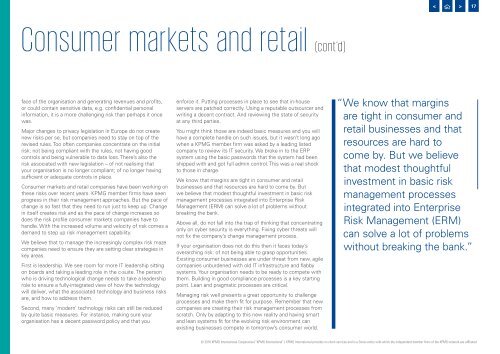Technology risk radar
2mQgADD
2mQgADD
Create successful ePaper yourself
Turn your PDF publications into a flip-book with our unique Google optimized e-Paper software.
17<br />
Consumer markets and retail (cont’d)<br />
face of the organisation and generating revenues and profits,<br />
or could contain sensitive data, e.g. confidential personal<br />
information, it is a more challenging <strong>risk</strong> than perhaps it once<br />
was.<br />
Major changes to privacy legislation in Europe do not create<br />
new <strong>risk</strong>s per se, but companies need to stay on top of the<br />
revised rules. Too often companies concentrate on the initial<br />
<strong>risk</strong>: not being compliant with the rules, not having good<br />
controls and being vulnerable to data loss. There’s also the<br />
<strong>risk</strong> associated with new legislation – of not realising that<br />
your organisation is no longer compliant; of no longer having<br />
sufficient or adequate controls in place.<br />
Consumer markets and retail companies have been working on<br />
these <strong>risk</strong>s over recent years. KPMG member firms have seen<br />
progress in their <strong>risk</strong> management approaches. But the pace of<br />
change is so fast that they need to run just to keep up. Change<br />
in itself creates <strong>risk</strong> and as the pace of change increases so<br />
does the <strong>risk</strong> profile consumer markets companies have to<br />
handle. With the increased volume and velocity of <strong>risk</strong> comes a<br />
demand to step up <strong>risk</strong> management capability.<br />
We believe that to manage the increasingly complex <strong>risk</strong> maze<br />
companies need to ensure they are setting clear strategies in<br />
key areas.<br />
First is leadership. We see room for more IT leadership sitting<br />
on boards and taking a leading role in the c-suite. The person<br />
who is driving technological change needs to take a leadership<br />
role to ensure a fully-integrated view of how the technology<br />
will deliver, what the associated technology and business <strong>risk</strong>s<br />
are, and how to address them.<br />
Second, many ‘modern’ technology <strong>risk</strong>s can still be reduced<br />
by quite basic measures. For instance, making sure your<br />
organisation has a decent password policy and that you<br />
enforce it. Putting processes in place to see that in-house<br />
servers are patched correctly. Using a reputable outsourcer and<br />
writing a decent contract. And reviewing the state of security<br />
at any third parties.<br />
You might think those are indeed basic measures and you will<br />
have a complete handle on such issues, but it wasn’t long ago<br />
when a KPMG member firm was asked by a leading listed<br />
company to review its IT security. We broke in to the ERP<br />
system using the basic passwords that the system had been<br />
shipped with and got full admin control. This was a real shock<br />
to those in charge.<br />
We know that margins are tight in consumer and retail<br />
businesses and that resources are hard to come by. But<br />
we believe that modest thoughtful investment in basic <strong>risk</strong><br />
management processes integrated into Enterprise Risk<br />
Management (ERM) can solve a lot of problems without<br />
breaking the bank.<br />
Above all, do not fall into the trap of thinking that concentrating<br />
only on cyber security is everything. Fixing cyber threats will<br />
not fix the company’s change management process.<br />
If your organisation does not do this then it faces today’s<br />
overarching <strong>risk</strong>: of not being able to grasp opportunities.<br />
Existing consumer businesses are under threat from new, agile<br />
companies unburdened with old IT infrastructure and flabby<br />
systems. Your organisation needs to be ready to compete with<br />
them. Building in good compliance processes is a key starting<br />
point. Lean and pragmatic processes are critical.<br />
Managing <strong>risk</strong> well presents a great opportunity to challenge<br />
processes and make them fit for purpose. Remember that new<br />
companies are creating their <strong>risk</strong> management processes from<br />
scratch. Only by adapting to this new reality and having smart<br />
and lean systems fit for the evolving <strong>risk</strong> environment can<br />
existing businesses compete in tomorrow’s consumer world.<br />
“We know that margins<br />
are tight in consumer and<br />
retail businesses and that<br />
resources are hard to<br />
come by. But we believe<br />
that modest thoughtful<br />
investment in basic <strong>risk</strong><br />
management processes<br />
integrated into Enterprise<br />
Risk Management (ERM)<br />
can solve a lot of problems<br />
without breaking the bank.”<br />
© 2016 KPMG International Cooperative (“KPMG International”). KPMG International provides no client services and is a Swiss entity with which the independent member firms of the KPMG network are affiliated.


